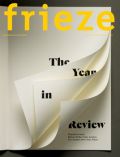 FRIEZE ISSUE 144
FRIEZE ISSUE 144 The January/February issue of frieze looks back over the significant events and issues of 2011, with a series of dispatches from Beirut, Berlin, Cairo, London, Los Angeles, New York and Tokyo.
As well as round-ups of the best films, architecture, design, music and publications of the year, these reports include:
–From London: Jennifer Higgie and Sam Thorne talk to Chris Dercon, the new director of Tate Modern and Dan Hancox revisits a year of unrest in the UK
–From Cairo: Negar Azimi considers art’s conflicted relationship with the Arab Spring, while, from Beirut, Kaelen Wilson-Goldie looks at artistic autonomy in Lebanon
–From Los Angeles: Stacey Allan and Sam Thorne report from ‘Pacific Standard Time’, an unprecedented survey of South Californian art between 1945 and 1980
–From Tokyo: Philip Brophy and Kyoji Maeda reflect upon Japan’s artistic psyche after the tsunami
–From The Netherlands: Moosje Goosen identifies the reasons and responses to arts funding cuts
–From Berlin: Jörg Heiser looks at the controversial factors behind the funding of the exhibition ‘Made in Berlin’
Elsewhere in the magazine, Lars Bang Larsen discusses ‘The Long 1990s’—suggesting that the social turn gave art ‘a new lease of life at a point that it had long been declared dead’—while artist Tania Bruguera discusses ‘Immigrant Movement International’ with Tate curator Kathy Noble: ‘All art is useful. But the Spanish word for useful ûtil also means “tool”. So we are talking about art as a social tool.’
On the back page, Carmen Herrera answers the ‘Questionnaire’.
There are also 40 reviews from 25 cities, including: Gerhard Richter at Tate Modern; ‘Postmodernism’ at the V&A; Creative Time’s ‘Living as Form’ in New York, the Third Thessaloniki Biennale; the Fourth Moscow Biennale; and ‘Videobrasil’ in Sao Paolo.